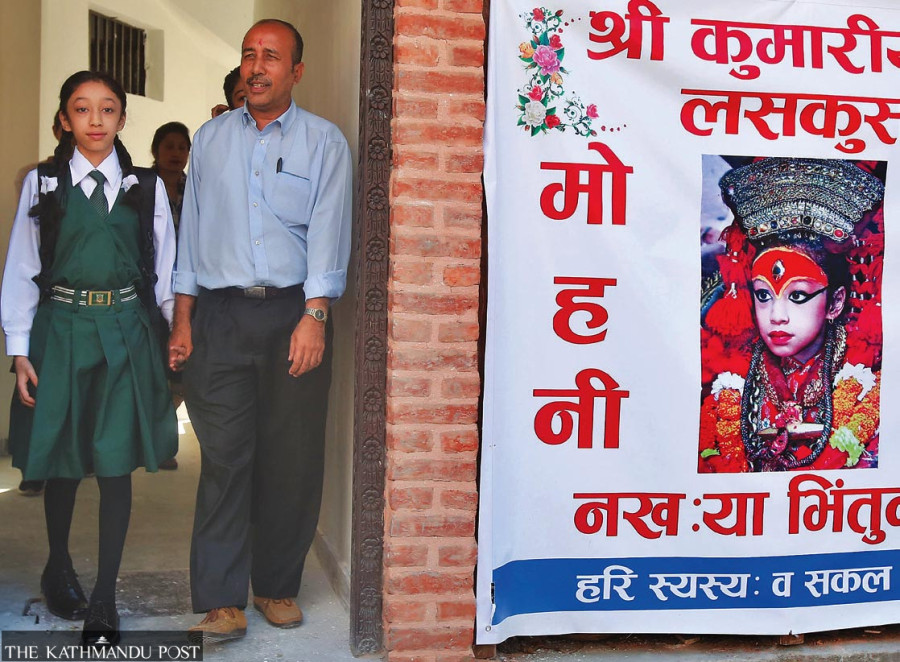National
The Kumari tradition lives on, balancing ancient and modern values
The tradition has faced scrutiny from rights advocates, but supporters argue the practice has adapted over time to safeguard the rights of the girls involved.
Shivangi Agarwal
In 2008 Matina Shakya was only three years old when she was appointed as the Kumari of Kathmandu. She was succeeded by Trishna Shakya as the new Kumari in 2017.
Kumaris are revered as goddesses of beauty and strength in certain Hindu and Buddhist traditions. Worshipping young girls as Kumaris is a 2,000-year-old practice in Nepal. Since the 13th century, when the Malla kings ruled, the Newars of the Kathmandu Valley have been worshipping Kumari, a girl from the Shakya/Bajracharya community chosen to embody the divine energy of goddess Taleju Bhawani. The reign of a Kumari ends when she starts menstruating. So long as she is serving as the Kumari, she is believed to be the nation’s divine protector, safeguarding it from evil.
Matina, 18, is now in her first year of college, studying for a bachelor’s degree in management. Her father, Pratapman Shakya, when asked about having a daughter who is the only living the goddess in the world said, “Not having your own daughter live in the same house as you seemed a little unfair, but we feel very proud to call ourselves the parents of the royal Kumari who is revered by people all over the world.”
On March 9, 2023, he, along with Matina, were getting ready for a special function held to honour all former Kumaris from across Nepal. “There are often events to honour Matina as she was the royal Kumari, but this one was dedicated to all former Kumaris from different areas. There are 129 living Kumaris in all,” he added. Besides Kathmandu, Kumari tradition is followed in Bhaktapur, Lalitpur, and Kirtipur, among other cities.
According to him, this was the first time an event like this was organised and the Deputy Mayor of Kathmandu, Sunita Dangol, was also in attendance.
Throughout the year, many people line up outside the ‘Kumari Ghar’ to get a chance to visit the Kumari and get her blessings. Many foreigners stand out in the yard to catch a glimpse of her. Nepali people believe that if a Kumari smiles at you, it is a bad omen.
Everyday, a tutor visits the Kumari to help her continue with her education as she is not allowed to step outside the Kumari Ghar. She takes her exams and does her homework from the Kumari Ghar itself. She also has the freedom to play inside the Kumari Ghar.
Many former kumaris have pursued careers in their fields of interest or studied after their term ends, and they continue to be treated with the same respect.
The tradition of Kumari has evolved over time. In the past Kumaris did not enjoy these freedoms.
Because of various superstitious beliefs, Kumaris were not fully educated and were forbidden from getting married because of the belief that the groom would die soon if he married an ex-Kumari. They led secluded lives, were restricted from participating in normal childhood activities, and focused solely on their religious duties.
However, now, these myths have been dispelled. Modern understanding has shifted to recognise that Kumaris, after stepping down from their divine role, have the freedom to marry and lead a normal life. The perception of Kumaris as isolated figures has evolved, with a focus on providing them with a more balanced upbringing.
There have been initiatives to integrate Kumaris into regular social and educational settings, allowing them to have a more holistic and fulfilling childhood experience. “Matina was already familiar with the students from the school that she attended after her term as Kumari ended,” said Shakya. “The kids visited the Kumari Ghar frequently so that she could have a smooth transition,” he added.
According to Gautam Prasad Shakya, who has been living as a caretaker in the Kumari Ghar, the changes made to the tradition are minor. “The traditions of Kumari have mostly stayed the same. All the rituals are still practised like in the old days,” he said.
On 6 May 2005, Pun Devi Maharjan, a lawyer, filed a case in the Supreme Court claiming that the traditional practice of electing young girls as Kumaris, or “goddesses’, who are expected to follow certain social restrictions and appear at religious festivals, violated the rights of the child.

Quoting Maharjan’s complaint, Puskar Mathema writes in Yuwamanch Monthly of October 2007, “If Kumari tradition is continued, it will undermine the fundamental rights as well the freedoms of children guaranteed by the constitution and child rights treaties. Apart from this, it will have a negative impact on their physical and mental development.”
The case continued while Nepal overthrew the monarchy and declared itself a secular state in 2007. When the judgement was pronounced in 2008, the goddess was still in her role, now giving blessings to the country’s President. The court ordered that the Kumaris and ex-Kumaris receive better benefits and arrangements and ordered the government to improve their support and allowances.
In April 2006, Prof Chunda Bajracharya filed a petition at the Supreme Court against Maharjan’s petition, who had argued against the Kumari tradition. Bajracharya contended that the tradition should be preserved as heritage due to its over 100 years of history.
“People who don’t understand the culture shouldn’t comment on it,” she stated. Bajracharya also criticised the human right activists who contended that Kumaris were only allowed to wear the colour red. “People who say Kumaris are forced to wear red clothing all the time, are the same people who send their kids to schools in uniform,” she said.
“After the 2008 court verdict, there have been a lot of improvements. Now, a teacher visits the Kumari Ghar daily to tutor the Kumari, who is expected to complete school assignments and sit periodic exams. All the former Kumaris now get benefits like scholarships and special pensions,” she added.
Bajracharya is currently a professor of literature at the Tribhuvan University in Kathmandu.
“The only significant change that the court verdict brought to the tradition was in terms of her education,” said Gautam Prasad Shakya, the caretaker. “Kumaris were tutored long before the case, but the case helped formalise this arrangement. After the court verdict, the time between 12 pm and 4 pm was designated as the Kumari’s tuition time,” he added.
After the verdict, there was a concerted effort to provide Kumaris with access to quality education, enabling them to develop the skills and knowledge needed to lead fulfilling lives beyond their divine roles. There was also a shift towards ensuring that the Kumari's living quarters are comfortable, safe, and conducive to her overall well-being.
Moreover, the selection process for the Kumari underwent reforms in the aftermath of the Pun Devi Maharjan case. There was a push for greater transparency, accountability, and inclusivity in the selection of the Kumari, with an emphasis on ensuring that the process was fair, respectful, and free from undue influence.
Efforts were made to support their transition into adulthood, including providing them with comprehensive resources for education, vocation, and social integration. This shift aimed to address the challenges faced by former Kumaris and empower them to lead independent and fulfilling lives after their divine service.
“The Kumari tradition has evolved over time. During the tenure of my daughter, we saw a lot of improvements. Even after her time as Kumari, Matina continued to get a lot of government support,” said Shakya, former Kumari Matina’s father.
“Some people argue that child rights are being violated, but all of her rights are being upheld inside the Kumari Ghar. This is a unique and respected aspect of Nepali culture, and I don’t believe it violates any of my child’s rights.”
While the Kumari tradition continues, its practices have evolved. “She enjoys this normal life and it didn’t take her long to adjust as well,” says Matina’s father, on her transition from the revered Kumari to the ordinary Matina.




 7.12°C Kathmandu
7.12°C Kathmandu










%20(1).jpg&w=300&height=200)



